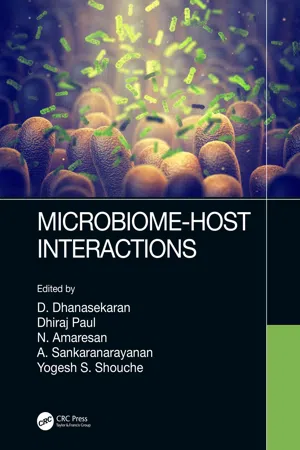
Microbiome-Host Interactions
- 420 pages
- English
- ePUB (mobile friendly)
- Available on iOS & Android
Microbiome-Host Interactions
About this book
Microbiota are a promising and fascinating subject in biology because they integrate the microbial communities in humans, animals, plants, and the environment. In humans, microbiota are associated with the gut, skin, and genital, oral, and respiratory organs. The plant microbial community is referred to as "holobiont," and it is influential in the maintenance and health of plants, which themselves play a role in animal health and the environment.
The contents of Microbiome-Host Interactions cover all areas as well as new research trends in the fields of plant, animal, human, and environmental microbiome interactions. The book covers microbiota in polar soil environments, in health and disease, in Caenorhabditis elegans, and in agroecosystems, as well as in rice root and actinorhizal root nodules, speleothems, and marine shallow-water hydrothermal vents.
Moreover, this book provides comprehensive accounts of advanced next-generation DNA sequencing, metagenomic techniques, high-throughput 16S rRNA sequencing, and understanding nucleic acid sequence data from fungal, algal, viral, bacterial, cyanobacterial, actinobacterial, and archaeal communities using QIIME software (Quantitative Insights into Microbial Ecology).
FEATURES
- Summarizes recent insight in microbiota and host interactions in distinct habitats, including Antarctic, hydrothermal vents, speleothems, oral, skin, gut, feces, reproductive tract, soil, root, root nodules, forests, and mangroves
- Illustrates the high-throughput amplicon sequencing, computational techniques involved in the microbiota analysis, downstream analysis and visualization, and multivariate analysis commonly used for microbiome analysis
- Describes probiotics and prebiotics in the composition of the gut microbiota, skin microbiome impact in dermatologic disease prevention, and microbial communities in the reproductive tract of humans and animals
- Presents information in a reachable way for students, teachers, researchers, microbiologists, computational biologists, and other professionals who are interested in strengthening or enlarging their knowledge about microbiome analysis with next-generation DNA sequencing in the different branches of the sciences
Frequently asked questions
- Essential is ideal for learners and professionals who enjoy exploring a wide range of subjects. Access the Essential Library with 800,000+ trusted titles and best-sellers across business, personal growth, and the humanities. Includes unlimited reading time and Standard Read Aloud voice.
- Complete: Perfect for advanced learners and researchers needing full, unrestricted access. Unlock 1.4M+ books across hundreds of subjects, including academic and specialized titles. The Complete Plan also includes advanced features like Premium Read Aloud and Research Assistant.
Please note we cannot support devices running on iOS 13 and Android 7 or earlier. Learn more about using the app.
Information
1
University of Beni-Suef
1.1 Introduction

1.2 Ecological Theory in Understanding of the Microbiome
1.3 Different Types of Microbiome
1.3.1 Microbiome
Table of contents
- Cover
- Half Title
- Title Page
- Copyright Page
- Table of Contents
- Foreword
- Preface
- Editors
- Contributors
- 1. An Insight of Microbiome Science
- Section I Omics and Computational Techniques Used for Microbiome Analysis
- Section II Human Microbiome
- Section III Animal Microbiome
- Section IV Plant Microbiome
- Section V Environmental Microbiome
- Index